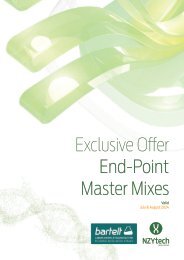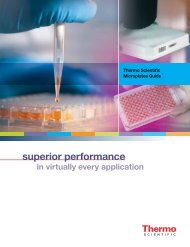PeloBiotech
You also want an ePaper? Increase the reach of your titles
YUMPU automatically turns print PDFs into web optimized ePapers that Google loves.
Cell Culture Tools<br />
• Cryo- and Cold-Management<br />
• Cell Culture supplements<br />
• Extracellular Matrices<br />
• Cell Culture Reagents<br />
• Transfection Tools<br />
• Reprogramming Tools<br />
• Safety Tools<br />
www.pelobiotech.com<br />
Cryo- & Cold-Management<br />
Cold- and cryo-preservation are critical steps while working with tissues and<br />
cells. Noteworthy to explain the importance of optimal, reproducible, and<br />
reliable cell work in clinical trials, cell therapies and regenerative medicine<br />
applications for humans and animals. It is obvious that basic research, drug<br />
development and compound testing will need the highest possible quality<br />
of cellular systems, too.<br />
Preservation is a critical, and often underappreciated, step in all research<br />
and clinical projects where tissues and cells will be used. It is best to optimize<br />
this process as early as possible to ensure reliable research, predictive<br />
compound testing, effective cellular therapies and highest possible<br />
cell/tissue quality.<br />
Cells can be isolated via cell separation (magnetic or non-magnetic procedures) or by tissue dissociation enzymes<br />
(collagenase & protease). In both cases the quality of cell source will be a critical factor. Cold preservation using special<br />
media which will help to keep the quality of tissues as high as possible. In many procedures cold- as well as cryo-preservation<br />
will be done.<br />
Cold-Preservation-Hypothermic Storage<br />
Storage of tissues and cells at low temperatures (4-10°C) for short periods (hours up to days) is defined as hypothermic<br />
storage. In the field of regenerative medicine cold preservation is an extension of principles and technologies used for<br />
whole-organ storage.<br />
Different media are available in the market for this application which were developed in many cases long before the<br />
explosion in cell therapy and tissue engineering. New media like HypoThermosol-FRS (BioLife) or Thermo-Gold (Revive)<br />
take the effects of cold shock damage (via stress pathways which are involved in necrosis and apoptosis) into account.<br />
Normally, cell or tissue function will be restored after 24 hours in culture at 37°C.<br />
Nevertheless, it is important to observe the post hypothermic storage viability for a week. Cells and tissues showing a high<br />
viability after warming can show a dramatic decrease after a few days. These effects depend on tissue or cell type.<br />
32
















